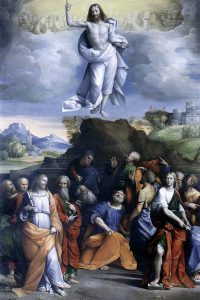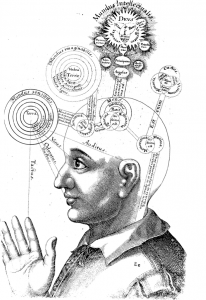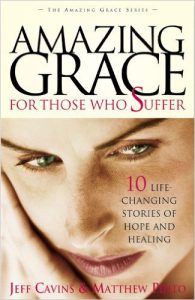All of us have two options on the following matter: either we’re materialists or believe there’s more to reality than mere matter. Either humans are just molecules and really smart animals, or we have a soul. Since we’re Catholic, all of us would naturally say we believe in a spiritual realm. But my experience is that most Catholics are more materialists (I used to be like this). Why? Because we’re taught in our culture that what’s important is what we can see and measure. If it can’t be proven by science then it’s not real. If, for example, we believe in God, angels, the soul, then that’s our belief, but it might not be true for other people, therefore it might not be true at all, and so how can we be sure it’s real?
 We celebrate today the Ascension of our Lord Jesus, when His humanity entered heaven. The Church reminds us that our destiny in life is something spiritual: to enter into eternal life, in union with God—this is all non-physical.
We celebrate today the Ascension of our Lord Jesus, when His humanity entered heaven. The Church reminds us that our destiny in life is something spiritual: to enter into eternal life, in union with God—this is all non-physical.
We’re continuing our series on what God allows suffering. We’ve talked about making our purpose in life the happiness of other people and eternal happiness. We know not only in our minds but also in our hearts that there’s “nothing you can do can change God’s love for you.” Today we need to know that eternal life is real and really want it.
Put simply: if our life ends here on earth, then most suffering will make no sense. We get cancer and our life is cut short—that’s a real bummer; nothing will cheer us up. But, if it’s true that we’re going to live for ever, then suffering here on earth isn’t the end. Nothing is completely lost. People may die before their time, we may suffer a lot in life, but, because our life doesn’t end here, we have perspective and can endure loss. God wants to redeem everything in eternity, in unconditional love and joy, and He will.
This is what we’re going to do: we’re going to give reasons that point and prove that we have a soul, one that survives death, and then show how this makes a difference in our lives. Some reasons will be more intuitive, some more logic-based, because there are different types of thinkers here.
 1) Jennifer Fulwiler was born an atheist and always believed what the ‘facts’ told her: that we’re made of molecules and nothing more. She started, however, to question these assumptions when her first child was born. She looked down at her amazing baby, this wondrous little creature, and asked herself, “What is this baby?” When she tried to think of him as a randomly evolved collection of chemical reactions, something didn’t seem right. To think that nothing about his personhood was eternal, that he was valuable only to the species, that, if a giant meteor hit the world tomorrow and all of humanity were wiped out, there would be no eternal reverberations; and that, even if a meteor didn’t strike, he like the rest of us, was destined to complete decay—all this seemed false. She thought of the love she had for her child, an overwhelming love that just completely took over her, and she didn’t believe that this love came just from the chemical reactions in her brain. Obviously chemical reactions are part of it, but for the first time in her life, she realized there was something outside the material world. That was the first moment she wasn’t an atheist because she believed in something extra-material (Jennifer Fulwiler, From Atheism to Catholicism, Track 4, 4:40).
1) Jennifer Fulwiler was born an atheist and always believed what the ‘facts’ told her: that we’re made of molecules and nothing more. She started, however, to question these assumptions when her first child was born. She looked down at her amazing baby, this wondrous little creature, and asked herself, “What is this baby?” When she tried to think of him as a randomly evolved collection of chemical reactions, something didn’t seem right. To think that nothing about his personhood was eternal, that he was valuable only to the species, that, if a giant meteor hit the world tomorrow and all of humanity were wiped out, there would be no eternal reverberations; and that, even if a meteor didn’t strike, he like the rest of us, was destined to complete decay—all this seemed false. She thought of the love she had for her child, an overwhelming love that just completely took over her, and she didn’t believe that this love came just from the chemical reactions in her brain. Obviously chemical reactions are part of it, but for the first time in her life, she realized there was something outside the material world. That was the first moment she wasn’t an atheist because she believed in something extra-material (Jennifer Fulwiler, From Atheism to Catholicism, Track 4, 4:40).
Her experience isn’t proof of a soul, but points us in the direction of a soul. Every human person has a natural propensity for the transcendent, sacred, and religious. That’s why people are still so interested in movies about magic and the supernatural: Harry Potter, Stars Wars and the Force, Avatar, Lord of the Rings, etc. The human person needs something more than this world. Why? Could it be because there’s something in us that’s eternal?
2) For many people, a lightbulb goes on with the following logic: There was once a debate between a materialist and a Catholic. The materialist said that everything we are is just molecules and even our thoughts are purely the result of our brains. So the Catholic asked, “How many inches long is the idea of justice?” The materialist replied, “Don’t be silly, ideas have no length.” “O.K. How much does it weigh?” “What are you doing? Trying to make a fool of me?” “No. I’m taking you at your word. What color is it? What shape?” (Frank J. Sheed, Theology for Beginners, 11). The point is this: the materialist said that thoughts are purely material/physical and the Catholic was just trying to find out what material characteristics it had. So, how can something purely material, like the brain, produce something that has no material properties? There must be something in us that is non-material that can do non-material things. Of course, our intellect uses the brain, but it’s the intellect that deals with abstract concepts.
One of our parishioners, Jaclyn Dee, who’s finishing her doctorate in cell and evolutionary biology, teaches a course at UBC: Science 113: First Year Seminar in Science. In part, it covers what science is and is not. They teach that science only deals with measurable things and acknowledge that not everything can be reduced to science. It can’t measure goodness, explain what is beauty, or what is right/wrong. It can measure brain waves, neurons firing, hormones, but not consciousness. It can study parts of consciousness but knows that it’s not reducible to that.
 3) Consider this: “My brain isn’t conscious; I am conscious. My brain doesn’t perceive or hear things; I do. My brain isn’t thinking; I am thinking… Certainly we use our brains to perceive and reason, just as we use our hands and feet to play tennis. But it is just as crazy to say my hands and feet are playing tennis as it is to say my racket is playing tennis. By the same token it is wrong to portray the brain as perceiving, feeling, thinking (Dinesh D’Souza, What’s So Great About Christianity? 246-7). It is the person, the subject, the “I” who does things. What is this “I”? It’s something that can only be measured partially by science.
3) Consider this: “My brain isn’t conscious; I am conscious. My brain doesn’t perceive or hear things; I do. My brain isn’t thinking; I am thinking… Certainly we use our brains to perceive and reason, just as we use our hands and feet to play tennis. But it is just as crazy to say my hands and feet are playing tennis as it is to say my racket is playing tennis. By the same token it is wrong to portray the brain as perceiving, feeling, thinking (Dinesh D’Souza, What’s So Great About Christianity? 246-7). It is the person, the subject, the “I” who does things. What is this “I”? It’s something that can only be measured partially by science.
Note the difference between the way we experience ourselves and the outside world. Everything we experience outside of ourselves is through our five senses, but when we experience ourselves it’s without our senses. Our experience of who we are is not through physical means.
4) Free will is another proof that something in people doesn’t follow natural laws. I can choose to drink a cup of coffee, knock it over, or leave it there. Nothing in nature forces me to do any of these things. Free will doesn’t follow the laws of physics, chemistry or biology, but stands outside of the material universe. Some things in us happen automatically, like our hearts beating, and these are beyond our free will, but some things can be freely chosen. And if ever someone says there’s no such thing as free will and that it’s just an illusion, slap them in the face and say, “Nature made me do it.” They’ll prove our point when they say, “You didn’t have to do that,” and “You shouldn’t have done that.”
5) Research on near-death experiences (NDE) actually point to a soul. Now this research isn’t hokey stuff from tabloids, but actual research from peer-reviewed journals (e.g. The Lancet (Britain’s best medical journal)) and over 30 years of studies with great controls and real doctors. In such cases, a person has something like a heart attack or drowns, is brain dead, and then resuscitated. During the time of brain death, they shouldn’t have any perception, be able to see or hear anything. Why? Because there’s nothing happening in the brain. But in about 25% of the cases, during the time of brain death, the consciousness leaves the body and starts seeing and hearing things in the operating room.
The research, of course, had to focus on unique, verifiable information: a patient would have seen or heard something, and then the researcher was able to verify it after the fact. It couldn’t be something obvious, for example, like machines in the emergency room or the use of defibrillators. It had to be something truly unusual that the patient saw and was able to verify afterward. E.g. one woman, while brain dead, “had knowledge of a shoe on a window ledge outside the hospital (not near the room where the patient was resuscitated, but next to a third-floor office where she was being interviewed). The psychologist who did the interview… had to crawl along the ledge outside her window to verify the claim. The shoe was indeed there precisely as the patient had described it. Though the shoe could have been seen from a window, the detail with which the NDE patient described it could not have been detected from that window (a worn little toe, a shoelace beneath the heel, etc.).” How did she know this when completely brain dead? This couldn’t have been a hallucination. E.g. “One man who had been in a deep coma, later told a nurse that he recognized her and saw where she had placed his dentures during resuscitation efforts, and even described the cart into which she placed them. They were there, precisely as he described it.” E.g. Another woman reported leaving “the operating room (after seeing the resuscitation efforts going on) and visit[ing]… relatives and friends in hospital waiting rooms… [She] overheard her brother-in-law talking to a business associate in the hospital waiting room in a very derogatory manner, and was able to report this back to him later.”
There has even been research on blind people who had near death experiences. 80% of them, while dead, were able to see, and most of them had been blind since birth! They had difficulty describing things like colour because they had never seen it before, but they described, for example, that red was brighter than other colours. Again, all their claims of sight had to be verifiable. And when they come back, they were blind again—hard to explain.
Some people who are brain dead actually go over to the other side and typically see a relative, Jesus, or a loving white light. They say something like, “I met Aunt Iris.” “But she died before you were born. How did you know?” “She told me the secret name of your teddy bear.” Even kids who aren’t christian see Jesus. When researchers ask, “How did you know it was Jesus?” they simply say, “He told me.” This is fascinating, because children have no agenda.
August 1, 1996 is the day Janet Moylan lost her husband, Tim, and their 10-year-old daughter, Jenni. They were on vacation with their five children in Mexico, and, while on the beach, a huge tidal wave came up and hit her three oldest children. The oldest daughter saw the wave coming, so ducked down and wasn’t dragged out into the water, but Jenni and her younger brother, Daniel, were pulled out. Tim ran in to save them, had Jenni in his arms, but they kept on getting lifted up by the waves and thrashed down. Daniel was thrust out and survived, but Tim and Jenni drowned. Janet watched all this at the beach and could do nothing to save them.
Janet writes, “My world had collapsed. There are no words to describe that moment. I was grief-stricken.” Most of the time we “lose and mourn one beloved person at a time but [she] had lost two—and the depth of the pain was at times more than [she] could bear.” Later that day, while in the hospital, Janet told Daniel about the death of his father and sister. Daniel, nine years old but mature beyond his years and full of faith, said, “At least we know they are okay now.” He and mom talked about them being with God, being at peace, and seeing his grandfather and two aunts. And he added, “And they get to see our baby!” referring to a sibling who was miscarried in 1984.
For a long time, the sorrow was overwhelming. Janet felt weak, couldn’t sleep, and every “first” without Tim and Jenni was tough: every first birthday, first photo, first day at school. A year later she writes, “As always, God was very good to me. During this tough time He blessed me with a dream that gave me great comfort. In the dream I sensed that there was a distance between Tim and me, and this really saddened me. I perceived we were not getting along and had not spent much time together. I was determined to get back together with Tim. I felt that if we could talk, everything would be okay. I had just started making small talk with him when I noticed he was wearing a magnificent robe that reached to his ankles. There was a pattern on most of the robe, a gold design on the white background, with the edges trimmed in gold cloth. It was unlike anything Tim ever would have worn on earth. He asked, ‘Do you life my robe?’ I was puzzled as to why he would buy a robe like that, but I answered, ‘You look like royalty.’ Tim was smiling and being like his old self, and I felt that everything was right between us again. Then I realized this was a heavenly robe…
I woke up crying. In my half-awake state I realized Tim had already died. My tears became tears of joy as I remembered how I had just seen and talked to Tim in is heavenly robe! I knew this was an important dream, and I never wanted to forget it. I immediately took out my notebook to record it. As I wrote down the day’s date, 7-11-97, I realized the significance of those numbers. Jenni and I celebrate our birthdays in August. Mine is on the seventh and hers is on the eleventh. Jenni once told me that seven and eleven are our special numbers…
 I see this dream as a gift from God. Jenni had been in the dream briefly, at the beginning. I was happy to see her again. God gave me a glimpse of Tim and Jenni to comfort me and to reassure me that they are in heaven” (Janet Moylan, “I Choose God,” in Amazing Grace for Those Who Suffer, 26-27).
I see this dream as a gift from God. Jenni had been in the dream briefly, at the beginning. I was happy to see her again. God gave me a glimpse of Tim and Jenni to comfort me and to reassure me that they are in heaven” (Janet Moylan, “I Choose God,” in Amazing Grace for Those Who Suffer, 26-27).
May God help us all to know that we’re meant for eternal life. Let’s focus more on Jesus and our faith. An important part of this is to change our lifestyle: more focus on prayer and fasting, which will convert our hearts and minds.
This truth makes all the difference. Suffering only makes if eternal life is real… and it is.